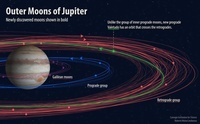"one of them is a weirdo"
We're still finding moons around Jupiter and reconstructing the history of the early solar system.

Enjoy being online again!
Welcome to the community of good people who base their values on evidence and appreciate civil discourse - the social network you will enjoy.Create your free account
3 comments
Feel free to reply to any comment by clicking the "Reply" button.We need probe out there to watch the inevitable collision!
The so-called weirdness is a retrograde rotational orbit.
BTW, six of the planets also rotate about their axis in this same direction. The exceptions—the planets with retrograde rotation—are Venus and Uranus. Venus's axial tilt is 177 degrees, which means it is spinning almost exactly in the opposite direction to its orbit.
Yep - so much for the conservation of angular momentum - solar system is still settling down from formation. Cool we still find surprises like this.
As a consequence, a year on Venus (225 Earth days) is just short of two Venus days (116 Earth days).
Fascinating! As a pool player, I'm reminded of what can occur on a break ... balls heading a every direction, some remaining close to their original position, and some spinning in opposite directions. Perhaps one day in the not-too-distant future we will be able to accurately (within an acceptable margin of error) model, and render, the forces and reactions that took place during the formation of our planetary system.
Recent Visitors 33
Photos 424 More
Posted by starwatcher-alThe occultation of Mars on the 7th.
Posted by starwatcher-alThe occultation of Mars on the 7th.
Posted by starwatcher-alSolar minimum was in 2019 so the sun is ramping up in flares, spots and prominences.
Posted by starwatcher-alI missed the early phases of the eclipse but the clouds mostly left during totality. All in all a great eclipse. Next one is Nov. 8-22
Posted by starwatcher-alI missed the early phases of the eclipse but the clouds mostly left during totality. All in all a great eclipse. Next one is Nov. 8-22
Posted by RobecologyFor those following the JWST.
Posted by AnonySchmoose The post-launch set-up of the new James Webb telescope has gone very well.
Posted by HumanistJohnImages taken with Stellina (80 mm): M33 Triangulum Galaxy M1 Crab Nebula NGC281 Pacman Nebula in Cassiopeia NGC 6992 Veil Nebula in Cygnus
Posted by HumanistJohnImages taken with Stellina (80 mm): M33 Triangulum Galaxy M1 Crab Nebula NGC281 Pacman Nebula in Cassiopeia NGC 6992 Veil Nebula in Cygnus
Posted by HumanistJohnImages taken with Stellina (80 mm): M33 Triangulum Galaxy M1 Crab Nebula NGC281 Pacman Nebula in Cassiopeia NGC 6992 Veil Nebula in Cygnus
Posted by HumanistJohnImages taken with Stellina (80 mm): M33 Triangulum Galaxy M1 Crab Nebula NGC281 Pacman Nebula in Cassiopeia NGC 6992 Veil Nebula in Cygnus
Posted by HumanistJohnImages taken October 2nd 2021 with Stellina 1.
Posted by HumanistJohnImages taken October 2nd 2021 with Stellina 1.
Posted by HumanistJohnImages taken October 2nd 2021 with Stellina 1.
Posted by starwatcher-al Did you know that you can see Venus in the daytime?
Posted by starwatcher-alOne of these days I think that I'll figure out this Nikon.







